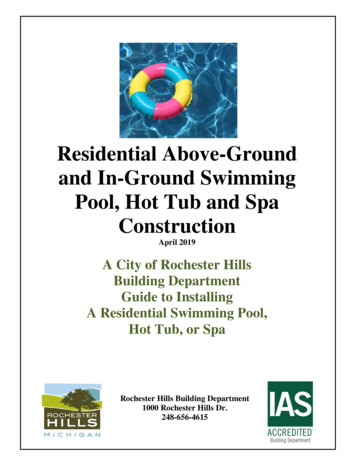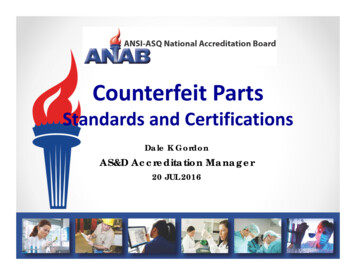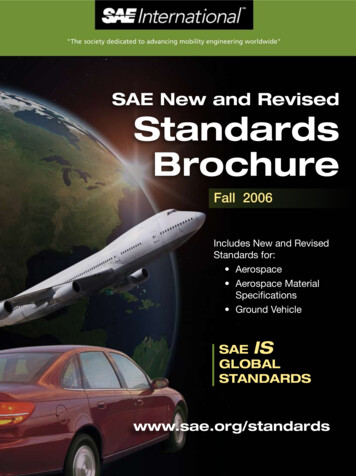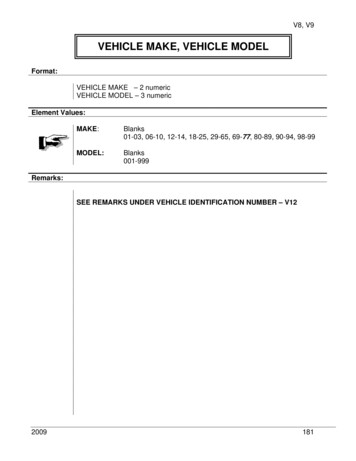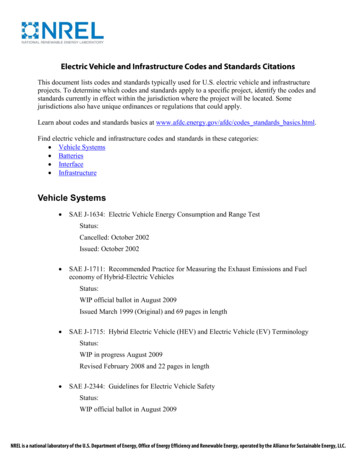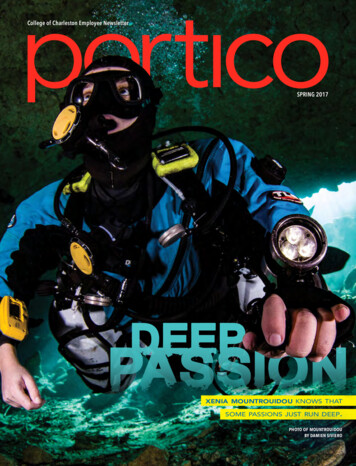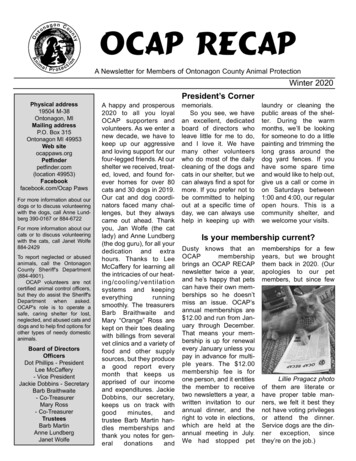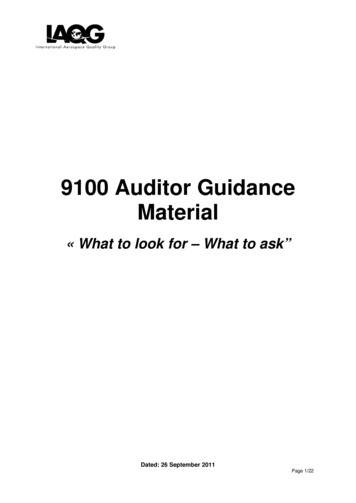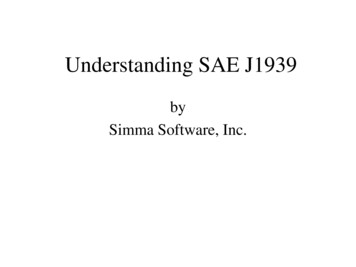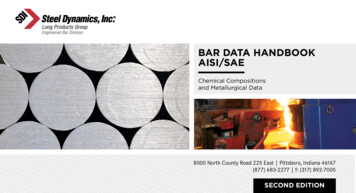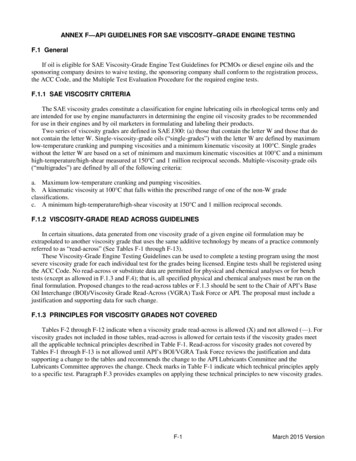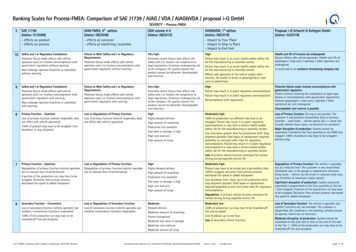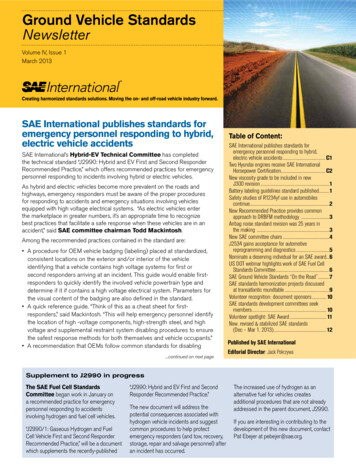
Transcription
Ground Vehicle StandardsNewsletterVolume IV, Issue 1March 2013Creating harmonized standards solutions. Moving the on- and off-road vehicle industry forward.SAE International publishes standards foremergency personnel responding to hybrid,electric vehicle accidentsSAE International’s Hybrid-EV Technical Committee has completedthe technical standard “J2990: Hybrid and EV First and Second ResponderRecommended Practice,” which offers recommended practices for emergencypersonnel responding to incidents involving hybrid or electric vehicles.As hybrid and electric vehicles become more prevalent on the roads andhighways, emergency responders must be aware of the proper proceduresfor responding to accidents and emergency situations involving vehiclesequipped with high voltage electrical systems. “As electric vehicles enterthe marketplace in greater numbers, it’s an appropriate time to recognizebest practices that facilitate a safe response when these vehicles are in anaccident,” said SAE committee chairman Todd Mackintosh.Among the recommended practices contained in the standard are: A procedure for OEM vehicle badging (labeling) placed at standardized,consistent locations on the exterior and/or interior of the vehicleidentifying that a vehicle contains high voltage systems for first orsecond responders arriving at an incident. This guide would enable firstresponders to quickly identify the involved vehicle powertrain type anddetermine if it if contains a high voltage electrical system. Parameters forthe visual content of the badging are also defined in the standard. A quick reference guide. “Think of this as a cheat sheet for firstresponders,” said Mackintosh. “This will help emergency personnel identifythe location of high -voltage components, high-strength steel, and highvoltage and supplemental restraint system disabling procedures to ensurethe safest response methods for both themselves and vehicle occupants.” A recommendation that OEMs follow common standards for disabling.continued on next pageTable of Content:SAE International publishes standards foremergency personnel responding to hybrid,electric vehicle accidents. C1Two Hyundai engines receive SAE InternationalHorsepower Certification. C2New viscosity grade to be included in newJ300 revision.1Battery labeling guidelines standard published.1Safety studies of R1234yf use in automobilescontinue.2New Recommended Practice provides commonapproach to DRBFM methodology .3Airbag noise standard revision was 25 years inthe making .3New SAE committee chairs.4J2534 gains acceptance for automotivereprogramming and diagnostics.5Nominate a deserving individual for an SAE award.6US DOT webinar highlights work of SAE Fuel CellStandards Committee.6SAE Ground Vehicle Standards “On the Road”.7SAE standards harmonization projects discussedat transatlantic roundtable.9Volunteer recognition: document sponsors. 10SAE standards development committees seekmembers. 10Volunteer spotlight: SAE Award. 11New, revised & stabilized SAE standards(Dec – Mar 1, 2013).12Published by SAE InternationalEditorial Director: Jack PokrzywaSupplement to J2990 in progressThe SAE Fuel Cell StandardsCommittee began work in January ona recommended practice for emergencypersonnel responding to accidentsinvolving hydrogen and fuel cell vehicles.“J2990/1: Gaseous Hydrogen and FuelCell Vehicle First and Second ResponderRecommended Practice,” will be a documentwhich supplements the recently-published“J2990: Hybrid and EV First and SecondResponder Recommended Practice.”The new document will address thepotential consequences associated withhydrogen vehicle incidents and suggestcommon procedures to help protectemergency responders (and tow, recovery,storage, repair and salvage personnel) afteran incident has occurred.The increased use of hydrogen as analternative fuel for vehicles createsadditional procedures that are not alreadyaddressed in the parent document, J2990.If you are interesting in contributing to thedevelopment of this new document, contactPat Ebejer at pebejer@sae.org.
.continued from previous pagehigh- voltage circuits and that vehicle OEMs provide a minimum of two methods of initiating thedisconnection and isolation of the high voltage system form the vehicle. OEM guidelines for the creation of second responder (i.e. tow truck operators) safetyinstructions for the inspection and handling of damaged or inoperable hybrid or electricvehicles, with a focus on the high voltage systems. “We want to see OEMs create a set of stepsto follow so second-responders use safe practices. The second responder community shouldbe made aware of proper procedures when towing, handling and/or storing a damaged orinoperable electric vehicle,” Mackintosh said.The National Highway Safety Transportation Administration participated in discussions and raisedconcerns over post-accident response. “Safety is our top priority. The entire industry wants toensure that first and second responders are prepared for accidents involving electric vehicles,”Mackintosh said.Two Hyundai engines receive SAE InternationalHorsepower CertificationFor the first time, SAE International has certified engines for passenger cars from non-U.S.automotive companies through the “SAE J1349 : Engine Power Test Code - Spark Ignition andCompression Ignition - As Installed Net Power Rating” technical standard.Hyundai submitted two engines used in the Elantra and Genesis models. Both engines werecertified and are now included in SAE International’s database. That database now includes nearly250 engines – including 210 from passenger cars and 37 from small utility vehicles.Engine certification is based on a series of self-certification tests conducted by the manufacturerthat are witnessed and verified by an SAE International-qualified observer. The procedure forcertification is outlined in SAE International’s standard J2723 (“Engine Power Test Code – EnginePower and Torque Certification”). The actual horsepower testing procedure is described in J1349.Engine manufacturers are free to cite power and torque figures derived from testing conductedoutside the scope of the SAE International standards, but in those cases they may not claim thosefigures are “SAE J1349 Certified Power .”SAE International’s Horsepower Certification Program was created in 2005. Small engines wereadded to be covered by the program in 2011 under the standard J1995, “Engine Power Test CodeSpark Ignition and Compression Ignition- Gross Power Rating.”The full list of certified engines can be accessed by visiting www.sae.org/certifiedpower.Delivery options for SAE Technical StandardsThe more than 10,000 standards in the SAE database now include historical standards, and canbe accessed through one of the targeted solutions below: SAE Digital Library is the industry’s most comprehensive resource, encompassing175,000 technical papers, standards, and related publications from SAE and other renownedorganizations. A customizable corporate solution! digitallibrary.sae.org SAE Subscriptions are online portfolios of SAE standards or technical papers focused ontargeted technologies and industries. subscriptions.sae.org SAE JPaks let you decide how many ground vehicle standards you need and when you needthem. Choose from packages that provide up to 10, 15, 25, 35, or 50 downloads per year.sae.org/jpaks SAE Ground Vehicle Standards on DVD provides convenient, portable access to morethan 2,400 individual standards, recommended practices, and information reports. sae.org/gvcdNew viscosity grade to be included in new J300 revisionThe publication of a revision to “SAE J300: Engine Oil Viscosity Classification,” is imminent. Thisrevision will introduce as new viscosity grade, SAE 16.The revision of J300 was requested by a consortium of passenger car OEMs to provide a newviscosity grade lower than SAE 20.“The main driving force for using lower viscosity oils is to lower hydrodynamic friction, therebyincreasing fuel economy,” according to Michael Covitch of Lubrizol, Chair of the SAE EngineOil Viscosity Classification Task Force. “The new grade will be specified in the future byOEMs for cars specifically designed to use new low viscosity oils. It is not deemed to be suitable foruse with older engines or newer vehicles not designed for such low viscosity oils.”Lower viscosity lubricants are expected to help OEMs meet Corporate Average Fuel Economy(CAFÉ) regulations, and help vehicle owners reduce costs.SAE J300 is used world-wide to classify engine oils in terms of viscosity grade. OEMs recommendspecific viscosity grades in the owners’ manuals to ensure that their engines will perform throughoutthe lifetime of the vehicle. Most engine oil standards set by organizations such as the AmericanPetroleum Institute and individual OEMs include requirements for oils to meet the limits found in J300.Battery labeling guidelines standard publishedA new Recommended Practice that covers labeling guidelines for electrical storage devices wasissued by the SAE International Battery Standards Labeling Committee in December 2012.“J2936: SAE Electrical Energy Storage Device Labeling Recommended Practice,” provideslabeling guidelines at all levels of component, subsystem and system level architectures describingcontent, placement and durability of requirements of labels throughout the total product lifecycle.It addresses dimensional, positioning, and copy nomenclature, product description, voltage andmanufacturing information, as well as end-of-life disposal, shipping and electrical connection data.For On- and Off-Road Harmonized StandardsSolutions, All Roads Lead to SAESince 1905, SAE International has been providing thecommon engineering requirements for new mobilityproducts, advanced technologies, and applications. Itis uniquely positioned to provide innovative standardssolutions to the global on- and off-road industries and theirengineering challenges.For automotive vehicles, SAE plays the central role indeveloping essential North American emissions and safetystandards to meet some of the most stringent regulationsin the world. Through ISO, it plays a key role in bringingstandards for and from the United States market to theglobal table. As the center of expertise on CommercialVehicle/ConAgg standards development, many of itsstandards are adopted by ANSI and ISO.SAE offers a full suite of standards capabilities—committeemanagement, consensus-based standards development,consortium administration, cooperative research, anddatabase development—providing industry, companies,and individuals with extensive opportunities to participate,influence, grow, and prosper.www.sae.org0716081
Safety studies of R1234yf use in automobiles continueAdapted from an article originally appearing in Automotive Engineering International Online, authoredby Paul WeisslerThe decision by Daimler to halt conversion toR1234yf—the low-global-warming-potential(GWP) but mildly flammable air-conditioningrefrigerant—has led to a vigorous defense of theproduct’s safety by the joint-venture suppliers,Honeywell and DuPont. Where does the industrygo from here?The first step, a review and possible expansion ofthe existing refrigerant-use risk assessments byan SAE Cooperative Research Program (CRP)of 13 OEM members, is under way. The SAEInternational Cooperative Research Project team(CRP1234-4), which was formed in 2012 toperform an updated engineering review of theR-1234yf refrigerant, met in early February.New Recommended Practice provides commonapproach to DRBFM methodology“SAE J2886: Design Review Based on Failure Modes (DRBFM),” developed by the AutomotiveQuality and Process Improvement Committee, was published in March.This Recommended Practice explains the DRBFM process and its recommended steps. It includesexamples of how to conduct the process and discusses how DRBFM can fit with activities such asproduct and process development, validation, production, and change management.DRBFM has been adopted by both automotive and non-automotive companies. There is a growingdemand for DRBFM information, as companies also expect their global supply base to utilize theprocess. As with FMEA, companies tend to use slight variations of the process which can causecomplexity for suppliers that support multiple companies. Development of a J2886, which providesa common approach to the implementation of the methodology, has been supported by users ofDRBFM from both manufactures and suppliers.Label on Cadillac ATS says it’s R-1234yf equipped.Note flame symbol in orange section at left.(Paul Weissler)The CRP continues its process of carefullyreviewing the use of R-1234yf by using universallyaccepted engineering methods, including analysis of recent OEM testing from actual vehicle crashdata, on-vehicle simulations, laboratory simulations, bench tests, and over 100 engine compartmentrefrigerant releases. Based on this testing the CRP has found that the refrigerant is highly unlikely toignite and that ignition requires extremely idealized conditions.German carmakers, Volkswagen in particular, had urged the close look at the Daimler data. Butonly Daimler actually faced a regulatory issue with the European Commission. Daimler’s decision tostop R-1234yf installations and retrofit cars already using the refrige
SAE J300 is used world-wide to classify engine oils in terms of viscosity grade. OEMs recommend specific viscosity grades in the owners’ manuals to ensure that their engines will perform throughout the lifetime of the vehicle. Most engine oil standards set by organizations such as the American Petroleum Institute and individual OEMs include requirements for oils to meet the limits found in .
